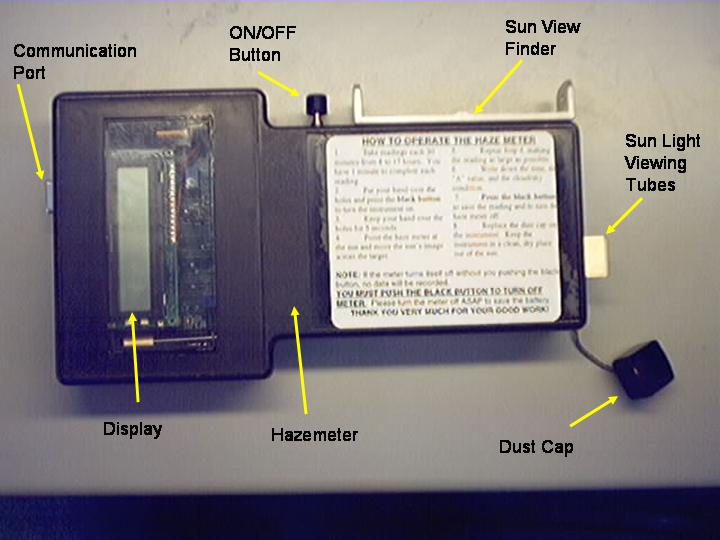
| The hazemeter instrument is a sun photometer that detects energy transmitted from the sun (See Figure 1). The hazemeter makes simultaneous measurements for each of the four sun light view tubes or photodiode filter channels. The photodiode filter channels isolate the following wavelengths from direct sunlight: 880 (infrared), 650 (visible), 500 (visible), and 405 nm (visible) (See Figures 2 and 3). When the energy travels through the sun light view tubes, the light passes through a filter that isolates a certain wavelength to be analyzed by the instrument. The instrument will record a voltage reading for each filter. The voltage is proportional to the strength of the energy determined at the specific wavelength. Aerosol optical thickness (AOT) can be calculated from these values to determine the type of aerosol present in the atmosphere. |
See the following links for more information:

Figure 1: A photograph showing the hazemeter instrument and pointing out the following areas: communication port, display, ON/OFF button, Sun View Finder, Sun Light Viewing Tubes, and Dust Cap
Figure 2: A diagram defining a wavelength (Source: GLOBE)
Figure 3: Wavelengths of the Electromagnetic Spectrum (Source: GLOBE)
| Data will be sent via Email to NASA for processing by David Giles. A program will check and calibrate the voltage data for each filter channel before calculating aerosol optical thickness (AOT). Once the voltages have been transformed to AOT, they will be displayed on the web page. The BSSN web site will allow the user to view and download the data for the available time intervals. |
NOTE:
|
Please download an excerpt from the GLOBE, Aerosol Protocols document. The document contains frequently asked questions and definitions of terms using in sun photometry. (PDF | TXT)
For more comprehensive information on the sun photometer and aerosols, please visit the GLOBE web site and GLOBE's Atmosphere Chapter. The GLOBE Program web site provides a wealth of information, however, please follow the measurement protocols presented at the BSSN web site. |